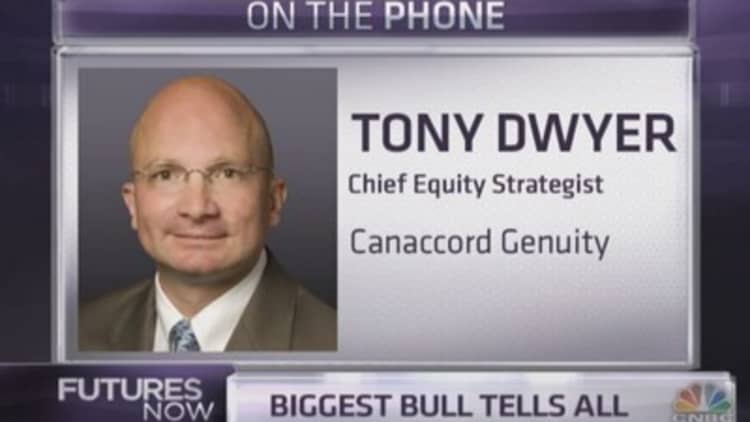
Will the Macarena once again sweep the nation?
Maybe not, but some say it feels a lot like 1996 regardless.
Canaccord Genuity's chief equity strategist, Tony Dwyer, has the highest year-end target on the Street, at 2,185, but nonetheless expects a 5 to 10 percent correction in the near term. When asked what catalyst would drive that drop, he pointed to what happened at the end of 1996.
"Let me give you a scenario: we're up 34 percent in one year, the next year we're up about 14, 16 percent, and all of a sudden, people are looking for reasons for a correction," Dwyer said on Tuesday's "Futures Now." "Nobody was thinking it was going to be Alan Greenspan […] giving an irrational exuberance speech, and in real bull markets, it's the unknown unknowns that come in and cause a 5 to 10 percent correction. It's just when the market gets very tired and it gets extended, you don't know what's going to cause it, but it comes in, and I think that's what we're set up for."
Read More Wall Street's biggest bull calls for a correction
In a speech on Dec. 5, 1996, then-Federal Reserve Chairman Alan Greenspan used that memorable phrase in a rhetorical question: "How do we know when irrational exuberance has unduly escalated asset values, which then become subject to unexpected and prolonged contractions as they have in Japan over the past decade?"
The S&P 500, which was already down slightly over the past few sessions, continued to slide, eventually taking the market down 6 percent, from high to low, over the course of 11 sessions. But from there, the market continued on a long road higher that didn't end for good until the 2000 tech-bubble top.
Dwyer's not the only one who says that given the market's steady climb higher, stocks are now vulnerable to any number of minor, but potentially scary, events.
"I agree that we are set up for 'something,'" said Jeff Kilburg of KKM Financial. "I like the analogy of the professional athlete: We are not necessarily expecting a career-ending injury for Mr. Stock Market, but a pulled hamstring should slow him down and seems imminent as he has been running too hard for too long. And don't forget—even a muscle cramp can sideline a top athlete and affect the outcome of a single game/fiscal quarter."
Read More Earnings expectations are driving stocks this year
"We have had a tremendous run in stocks and a corrective phase has been well-earned," echoed Jim Iuorio of TJM Institutional Services. "What's more important is to determine if the landscape is such that a small quote or event could trigger a correction. I think the answer to that is 'Yes,' but not overwhelmingly so."
On the other hand, the continued stimulus provided by today's Fed could mean the apparent complacency in the market is well-founded.
"It's hard to compare today to any other time," said Anthony Grisanti of GRZ Energy. "We've never had the Fed so engaged, or trying so hard to manage the economy. Investors are looking to the Fed as a backstop."
And it's worth nothing that even if it is 1996 again, that's probably a better reason to hold off on buying than to sell out of one's positions. So short-lived was that December hiccup that by the time the year ended, the S&P had already made back nearly all of those losses.
—By CNBC's Alex Rosenberg.
Watch "Futures Now" Tuesdays and Thursdays at 1 p.m. ET exclusively on FuturesNow.CNBC.com!



